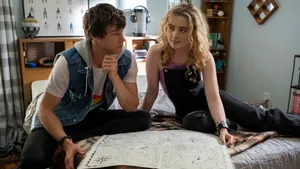Stay in the Loop
BSR publishes on a weekly schedule, with an email newsletter every Wednesday and Thursday morning. There’s no paywall, and subscribing is always free.
Time to deconstruct determinism
What can ‘Naked’ and ‘Map of Tiny Perfect Things’ teach us about unsticking our lives?

Making peace with the place you’re stuck in isn’t about creating a perfect slate of activities that allow you to be maximally happy and minimally anxious. That’s what I argued six months ago, in my first Broad Street Review essay about what time-loop films taught me in quarantine. Back then, I used Groundhog Day and Palm Springs to make the case that time-loop films show us how to sit still inside the extended pause of the pandemic. But continuing my time-loop film festival with Michael Tiddes’s 2017 Naked and Ian Samuels’s 2020 The Map of Tiny Perfect Things made me realize there was more happening inside the enforced stillness of the pandemic than I’d seen last December. My perspective evolved around the same time that I started hearing a short but powerful phrase repeated over and over again by folks all around me: It’s time.
One of my coworkers decided to retire this year; two colleagues decided to go back to school for advanced degrees. Several people I know who had been on the fence about starting a family decided to take the plunge, and are either expecting children or have recently had them. I have never sent so many congratulatory messages in such a short period. One friend and her husband bought a new house, deciding to finally commit to their city after years of being unsure if it was the place for them; yet another friend did the complete opposite and quit a job she had been at for nearly 15 years to start a new life across the world.
As different as each of these decisions was, they shared a common thread: people made them after the extended pause of the pandemic gave the clarity to see what they actually wanted out of their lives. It’s time, they all said, not merely suggesting that it was the right time, but perhaps even that these moves were overdue.
The real sticking point
In the time-loop films that I seem to have become obsessed with over the course of the pandemic, characters’ escapes from their various loops relied upon their figuring out the changes they needed to make to themselves and their lives. Each film’s actual escape vehicle is completely different from the next—in The Map of Tiny Perfect Things, Mark and Margaret embark on what amounts to a scavenger hunt of perfect moments in their looped day; in Naked, Rob has to learn how to take himself seriously and engage with his community honestly. In Groundhog Day and Palm Springs, Phil has to learn how to be a good person on principle rather than transactionally, and Nyles and Sarah must find—then act on—the courage to live with trust and vulnerability in the linear-time world.
Regardless of what propelled these protagonists into their respective time loops, all the characters ultimately must find it in themselves to want more out of their lives than what they had settled for. In other words, they’re not stuck because of the time loop—they were, all of them, already stuck, long before the loop showed up to illustrate the point and shake them out of it. The degree to which they had acquiesced to lives they were unhappy with may have even created the glitch in time—causing time, in their lives, to freeze at the very nexus of their settling, at the moment that represented the worst of their lives’ existential petrification.
It makes perfect sense, then, that these characters’ exits from their time loops are nothing more than a long, painstaking process of becoming unstuck. Gradually learning to examine every corner of every looped day, these protagonists must deconstruct the toxic determinism that first got them into the loop, thus revealing the truth that anything—indeed, everything—could be changed if only they applied intention to it.
Using the infinite loop
It’s time. In the context of the many large life changes I’ve observed in my communities, that small phrase suddenly takes on new weight. Not just that it was time for those changes, which it no doubt was; but perhaps that it was time, in itself. Time, in its most expansive sense, gave them a needed window into the truths of their lives—the stretched sense of time that seemed to encompass the pandemic, days that felt quick as a blink yet simultaneously widened into a searing infinity.
Why do I still use that broken coffee pot? Why haven’t I replaced my bed, years after noticing its sagging middle and the unsettling creaking of the box spring? Why do I still live in Philadelphia? These are questions that it seems none of us had time for before the pandemic, even those of us well versed in introspection, whether by nature or out of professional necessity. Now, though, in the infinite loop of our days, these questions have burst through the silences—the flat places where we are on autopilot, the rugged places where we have added new routines to protect our sanities—and forced their ways irrevocably into our lines of sight.
If we lean into the bracing silences of the pandemic time freeze, we can begin to hear resonances of the things we have long silenced, the desires we have been too scared to heed for fear of upending everything we have built our lives upon until now. The time-loop films show us the power of using this extended freeze to examine our lives; perhaps not all of us are as deeply stuck as the protagonists in these films, but I think that all of us stand to gain from a deliberate, up-close look at the structural integrity of our lives, and see if they measure up to what we told everyone and ourselves we wanted and believed.
If our lives turn out to be in order, then great. But if not, we can take our instruction manuals on the extrication process from these time-loop films too: a painstaking peeling away of the stagnant underlying assumptions of our lives, slowly but definitively getting our lives unstuck. Within the confines of the looped time of the pandemic, we, too, can take control of the minutiae of our days and map our ways out. For the lives we really want await us, on the other side of the loop.
Image description: A scene from The Map of Tiny Perfect Things. A young man and woman look meaningfully at each other while sitting on a bed, a map spread out between them.
Sign up for our newsletter
All of the week's new articles, all in one place. Sign up for the free weekly BSR newsletters, and don't miss a conversation.

 Michelle Chikaonda
Michelle Chikaonda